| Vocademy |
Oscillators
An oscillator is a circuit that produces a repetitive, changing output signal. They are used as clocks for timing circuits, to drive digital circuits or as essential components of radio circuits.
There are two main types of oscillators: harmonic oscillators (LC oscillators) and relaxation oscillators (RC oscillators).
Harmonic Oscillators
A harmonic oscillator uses a parallel resonant circuit (a tank circuit) to determine the frequency of oscillation. As explained in Resonant Circuits, energy can be made to go back and forth between the inductor and capacitor of a tank circuit. This will happen at the resonant frequency of the circuit. The tank circuit is connected to an amplifier such that the amplifier adds just enough energy to the circuit, at just the right time, to make up for the power dissipated by the inherent resistance. This keeps the tank circuit oscillating rather than damping out as the energy is lost.
To produce a sine wave the gain of the circuit must be exactly 1. If the gain is greater than 1, the amplitude of the oscillations will get larger with each cycle until the transistor begins swinging between saturation and cut-off, thus producing square waves. It may even lock up and stop oscillating. If the gain is less than 1, the oscillations will die out and the circuit will stop oscillating.
Therefore, to sustain oscillation and produce a sine wave, a harmonic oscillator must feed the output back into the input timed such that the input is boosted by the feedback (positive feedback) and the amplifier must have a gain of unity (a gain of 1).
Armstrong Oscillator
The Armstrong oscillator is named after Edwin Armstrong, the inventor of the circuit as well as several other important radio circuits. The inductor of is part of a transformer. The other part of the transformer is in the collector circuit of the transistor (the drain circuit of an FET). There is a 180-degree phase shift between the coils of the transformer, providing the needed positive feedback.
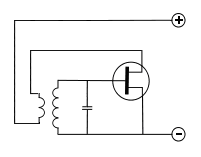 |
| An Armstrong Oscillator |
Colpitts Oscillator
A Colpitts oscillator uses a tank circuit with two capacitors. The junction between the two capacitors is connected to ground. The tank circuit naturally oscillates at its resonant frequency. Since the junction between the two capacitors is grounded, each end of the tank circuit swings back and forth between positive and negative voltages at opposite times (180 degrees out-of-phase with each other). Connecting this tank circuit between the output and input of a common-emitter amplifier creates a Colpitts oscillator.
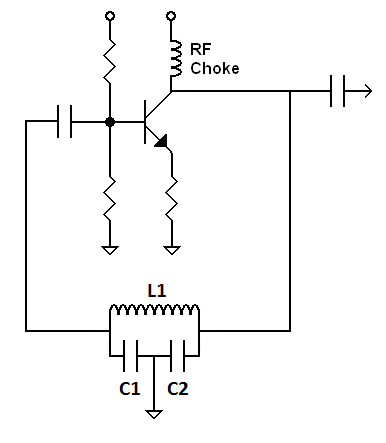 |
| A Colpitts Oscillator |
Recall that the output of a common-emitter amplifier is 180 degrees out-of-phase with the input. The voltages at the ends of the tank circuit are also 180 degrees out-of-phase with each other (when one end has a positive voltage the other end has a negative voltage). Placing the ends of the tank circuit between the amplifier input and output provides the proper timing to boost the voltage in the tank circuit.
The diagram above is typical of Colpitts oscillators in electronics textbooks. You can see the design for a working model at Electronics Tutorials. You can find another layout at Instructables. This layout is still a Colpitts oscillator (identified by the two capacitors in the tank circuit). However, it achieves positive feedback through a different path.
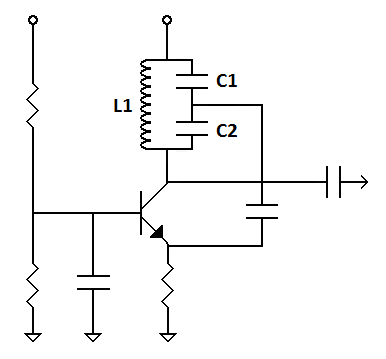 |
| Another Layout of a Colpitts Oscillator |
Hartley Oscillator
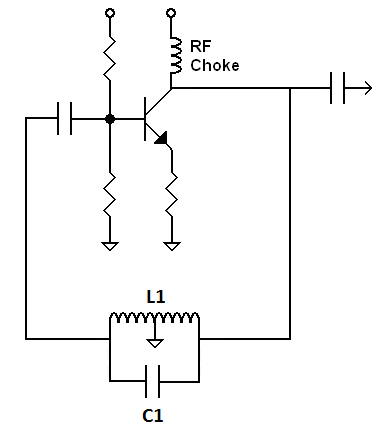 |
| A Hartley oscillator |
The Hartley Oscillator works on the same principle as the Colpitts oscillator. However, the Hartley oscillator has two inductors instead of two capacitors. In the above circuit, the inductors consist of a single inductor tapped and grounded at the center. You can see a working design for a Hartley oscillator at Learn About Electronics.
Pierce Oscillator
A Pierce oscillator uses a quartz crystal to control the frequency. This crystal is ground to a precise size and shape that vibrates at the desired frequency, which can be in the megahertz range. Using a quartz crystal, a Pierce oscillator is very stable.
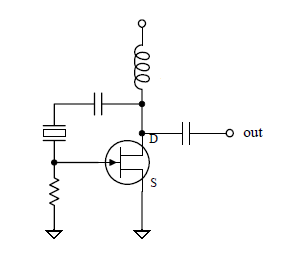 |
| A Pierce Oscillator |
Relaxation Oscillators
A relaxation oscillator works by repeatedly charging a capacitor until a set threshold is reached, then discharging it and repeating the cycle.
One type of relaxation oscillator is made by placing a neon lamp in parallel with a charging capacitor. During most of the charge cycle, the neon lamp is an open circuit. However, when a certain voltage is reached (determined mostly by the distance between the electrodes of the neon lamp—about 90 volts for a typical neon lamp). When this voltage is reached, the neon gas will ionize, becoming conductive. This quickly discharges the capacitor, dropping the voltage below the ionization voltage and restarting the cycle.
 |
| A Neon Lamp Relaxation Oscillator |
Unijunction Transistor Oscillator
The unijunction transistor (UJT) is obsolete, but you may find UJT relaxation oscillators in older circuits. This oscillator works like the neon lamp relaxation oscillator, but with lower voltages. The positive side of the capacitor is connected to the emitter of a unijunction transistor. As the emitter voltage rises a tiny amount of current flows into the emitter. When a certain threshold voltage is reached (set by external resistors) the UJT goes into a condition called negative resistance[1]. There is a sudden cascade of current into the emitter causing a corresponding decrease in voltage. This discharges the capacitor and starts the cycle over again.
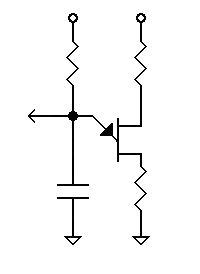 |
| A UJT Relaxation Oscillator |
Op-amp Hysteresis Oscillator
The op-amp relaxation oscillator uses hysteresis to control the timing of the oscillations. Hysteresis is a property of systems that have two stable states. The system will not change from one state to the other unless it passes a certain threshold.
The following square wave generator uses hysteresis as part of the timing system to control the frequency (the circuit is a type of relaxation oscillator).
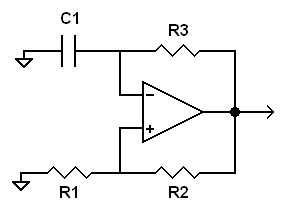 |
| Op-amp hysteresis oscillator |
To analyze this circuit, assume that it is powered by dual 10-volt power supplies and that R1 and R2 are equal. When the power is applied to the circuit, the output will randomly go to either the positive or negative power supply voltage. The capacitor will appear as a short circuit since it has no charge at this point. Assume that the output went to +10 volts when power was applied. This will cause the voltage at the non-inverting input to be +5 volts. Therefore, the initial state is: the capacitor is discharged putting 0 volts on the inverting input, the output is +10 putting +5 volts at the non-inverting input. This holds the output at +10 volts and applies +10 volts to the RC circuit comprised of R3 and C1.
Over time the capacitor will charge causing the voltage at the inverting input to rise. When this voltage passes +5 volts, the voltage at the inverting input becomes more-positive than the voltage at the non-inverting input. This causes the output to go suddenly to -10 volts.
With the output at -10 volts the non-inverting input is at -5V. The capacitor is still charged to +5 volts holding the inverting input at +5 volts. Therefore, the inverting input is still more positive than the non-inverting input, holding the output at -10 volts. However, the RC circuit now has -10 volts applied to it and the capacitor begins to discharge (charge to the opposite polarity) toward this voltage. When the capacitor voltage falls past -5 volts, the non-inverting input will be more positive than the inverting input causing the output to suddenly go to +10 volts. This puts the voltage at the non-inverting input back to +5 volts and changes the voltage applied to the RC circuit back to +10 volts. This causes the capacitor to begin charging back toward +10 volts. This will continue until the capacitor voltage passed +5 volts and the cycle repeats. Each time the cycle repeats, the output of the op-amp swings from +10 volts to -10 volts and back.
If R1 and R2 are not equal, the threshold where the output switches from one voltage to the other changes. This affects the frequency of oscillation along with R3 and C1. The duty cycle (the "on" time compared to the "off" time) can be varied by changing the voltage where R1 is connected to ground in the example circuit.
Wein-bridge Oscillator
The Wein-bridge oscillator gets its name from the fact that it can be seen as a bridge circuit. A Wein-bridge oscillator can produce sine waves over a wide range of frequencies.
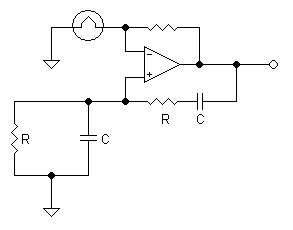 |
| Wein-bridge Oscillator |
The circuit shown above is based on early Wein-bridge oscillators. It uses an incandescent light in place of a resistor in the negative feedback circuit. This provides stability. When the output voltage rises, more current passes through the light bulb, raising the temperature of the filament. This increases the filament resistance, which increases the voltage at the inverting input even more than would occur if a resistor alone were in its place. This increases negative feedback thus keeping the output from increasing. Without the light bulb, the output of the circuit would tend to increase until the circuit saturates and clips the sine waves.
The above circuits are only a few of the of oscillator circuits that you may encounter. Many others suit the needs of particular applications.
|
Prelude to Oscillators |
Oscillator Fundamentals |
|
Astable Multivibrator |
Wien-bridge Oscillator |
|
Colpitts and Hartley Oscillators |
Armstrong Oscillator |
|
Crystal Oscillators |
Relaxation Oscillator |
|
Blocking Oscillators |
Blocking Oscillators |
|
Clapp, Vackář, and Seiler Oscillators |
Tunnel Diode Oscillators |
|
Variable Duty Cycle Op-amp-based Relaxation Oscillator |
Revisited - Variable Duty Cycle Op-amp-based Relaxation Oscillator |
—————————
| 1 | Negative resistance is a condition where increasing the current through a device causes a decrease in voltage, the opposite of normal conditions. The tunnel diode is another device that exhibits negative resistance. |
| Vocademy |